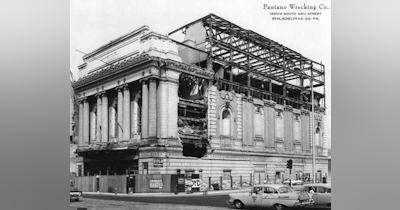The actor William Arliss, in a photo from Vanity Fair magazine (left), February 1923, and in 1921 as the Raja of Rukh (right), in The Green Goddess (collection of the City Museum of New York).
Below, a newspaper advertisement for the World Premiere opening night of The Green Goddess at the Walnut Street Theatre on December 27, 1920.
A Green Goddess production photo of Arliss as the Raja, entertaining his unexpected guests. Olive Wyndham, playing the character of Lucilla, is center.
Below, the three main actresses of The Adventures of Chlora at the newly-opened Little Theatre on Delancey Street in Philadelphia, March 1913.
Below, a 1913 photograph of how the old Walnut Street Theatre looked in its last years before the renovation we discuss in the episode. The cigar store on the corner of 9th Street was still there, as was the massive iron fire escape installed on the front of the building around the turn of the century. The inscription "Oldest in America: 1808" can still be seen high up on the facade. The surrounding neighborhood was still bustling - mostly with the publishing and newspaper industry - but by 1913 it was much less fashionable as a place to live and to see plays. The attractive area of town for theater-going in Philadelphia was now farther to the west, along Broad Street near City Hall.
Down the street is the fortress-like bulk of Gilmore's Auditorium, which by this point in time was mainly a burlesque venue. It was torn down in the 1930s, and the resulting empty lot was cleared for parking automobiles, the function it serves to the present day. (The Walnut Street Theatre owns this lot, and has several times announced plans to build an expansion on it, including a new performance space - but as of this writing these plans remain on hold.)
Next, a photo taken around 1940, showing how the facade of the Walnut looked after Edward Lee's 1920 renovations were completed. The corner became the site of the theater box office, the cornice and windows were altered, the fire escape from the balcony was moved to 9th Street, and the eastern portion of the theater's building became offices and rehearsal rooms.
Two views of the Walnut's auditorium after the renovations, showing the new chandelier imported from The Bingham House, and the left and right sides of the house. (The old Walnut Street Theatre eagle on the proscenium arch survived the subsequent 1970 renovations, and is now in the second floor lobby of the theater.)
Finally, the earliest citation I can find for the story of green goddess dressing being invented in honor of George Arliss when he was performing in San Francisco. From the Detroit Free Press May 12, 1946:
Selected Bibliography:
Books
Archer, Charles, William Archer: Life, Work and Friendships. Yale University Press, 1931.
Davis, Andrew, America's Longest Run: A History of the Walnut Street Theatre, pp. 198 -212. The Pennsylvania State University Press, 2010.
Mantle, Burns, editor, The Best Plays of 1920-21, “The Green Goddess” pp. 124-161. Dodd, Mead & Company, 1930.
Newspaper Articles (in chronological order)
"A Week of Promise for First Nighters," Philadelphia Inquirer, March 2, 1913, p. 39.
"New Little Theatre," New York Tribune, March 4, 1913, p. 9.
"Little Theatre Makes Its Bow," Philadelphia Inquirer, March 4, 1913, p. 11.
“Walnut to Reopen Soon,” Philadelphia Inquirer, September 8, 1918, p. 34.
“Chestnut Opera House and Walnut Theatre Are Sold,” Philadelphia Inquirer, March 9, 1920, p. 1.
“America’s Oldest Playhouse,” New York Times, April 25, 1920, p. 94.
“Walnut To Play Shubert Shows,” Philadelphia Inquirer, May 9, 1920, p. 84.
“Future of the Old Walnut St. Theatre,” Philadelphia Inquirer, May 14, 1920, p. 30.
“Souvenir Canes for Notables,” Philadelphia Inquirer, May 16, 1920, p. 86.
“Rare Woods in Old Walnut St. Theatre,” Mahanoy City Record-American, May 25, 1920, p. 3.
“New Walnut Reopened With ‘Green Goddess’,” Philadelphia Inquirer, December 28, 1920, p. 8.
“The Call Boy’s Chat,” Philadelphia Inquirer, January 2, 1921, p. 30,
















